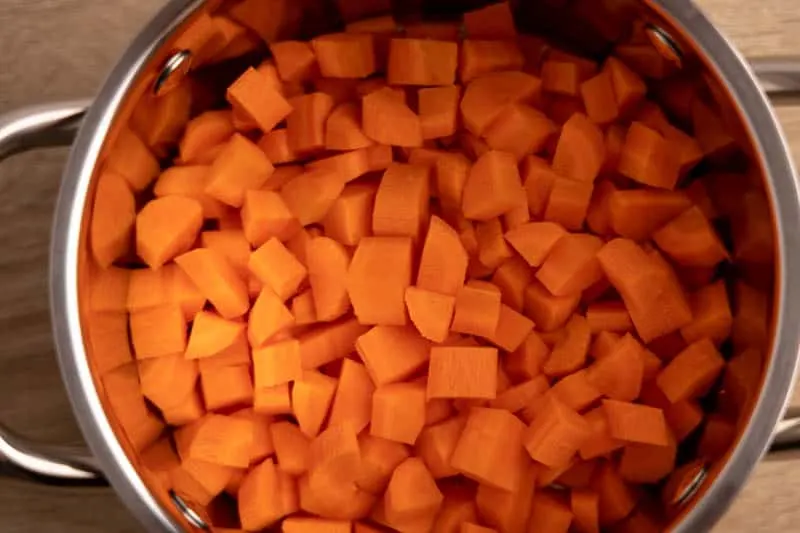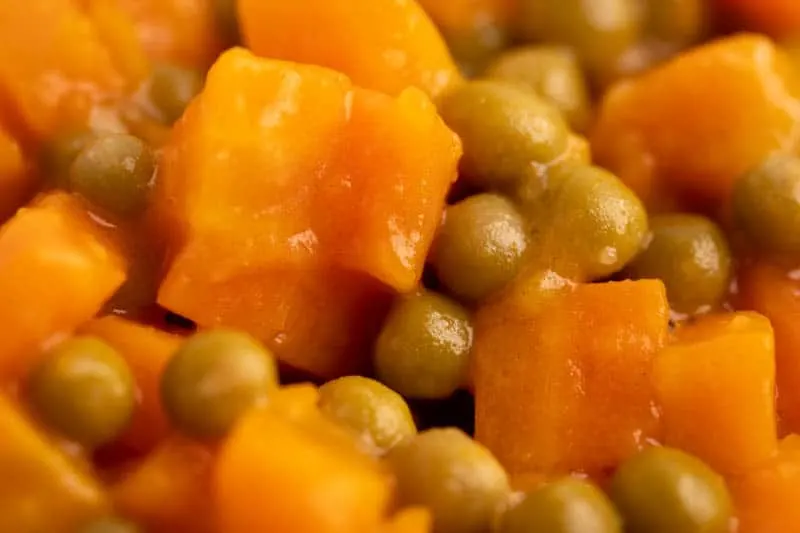You went crazy on a deal on carrots and bought way too many. How long do carrots last before they go bad and what’s the best way to store them?
This article covers precisely those topics: signs of spoilage, shelf life, and ways to store carrots. As an extra, we talk about freezing those root veggies too.
If that sounds like what you need, read on.

How To Tell If a Carrot Is Bad?
Carrots can go bad in the traditional way (rot, mold), but they can also deteriorate in terms of quality to the point they’re not usable anymore.
Here’s what to look for:
- The veggie starts to rot or grow mold. If the skin and flesh are going back, or there’s some white fuzz on the surface, that’s what’s happening. If only a part is affected, you can cut it off and use the rest, just like you do with potatoes and other veggies.
- The carrots is limp, rubbery, or bendy. Such carrots aren’t unsafe to eat by any means, but peeling them is a huge pain, and they don’t taste that good. You can either discard them or use in a cooked dish, where the lack of firmness isn’t noticeable.
If a carrot is only slightly soft, it’s still good enough for salads and eating it raw.

How Long Do Carrots Last?
Carrots last for 4 to 7 days in the pantry, and between a month and two months in the fridge. Cooked carrots keep for about 5 days.
In the pantry or anywhere else that’s near room temperature or slightly below, the carrots usually last between 4 to 7 days. If they are fresh, they can last up to 10 days ([CM]).
Temperature affects the shelf life significantly. If it’s the middle of a hot summer, expect the carrots to last 3 to 5 days at room temp (if you don’t have air conditioning).
When it comes to the fridge, carrots last between a month ([SOF]) and 2 months ([CM]), depending on how you store them.

How To Store Carrots?
First, if your carrots came with the greens intact, cut them off ([SOF][CM]). You do the same for beets and radishes, in case you were wondering.
The greens pull moisture from the root (the carrot), so cutting them off is a must if you don’t want the carrots to dry out quickly.
If you want to use the greens, pul them in the fridge wrapped in a damp paper towel ([SOF]).
Second, no matter if the carrots end up in the pantry or the fridge, keep them away from fruits and veggies that produce ethylene, such as apples or bananas. That gas speeds up ripening, so you don’t want it anywhere near the carrots.
Third, postpone washing the veggies until you’re ready to use them.

Now, it’s time to talk about moisture.
If you keep the carrots at room temp, they should be in a well-ventilated place, so that the moisture doesn’t build-up and cause the carrots to rot.
A veggie basket on a shelf (not in sunlight) or in a cabinet that you open every day should work just fine.

If you store carrots in the refrigerator, there are two options: you keep them dry or submerge them in water.
The former means you put them loose in the veggie drawer or you poke some holes in the plastic bag so that the moisture can get out.
For bonus points, you can wrap the carrots in paper towels that will absorb the moisture ([SOF][CM]). If you do that, check on the carrots every couple of days, and switch the paper towels if the current ones are wet.
You can dry out damp paper towels and reuse them later.

For the latter, you pick an airtight container, place all carrots in it, and add water so that it covers the produce completely ([SOF][CM]). Then seal the container and put it in the fridge. Change the water every 3 to 4 days or whenever it gets cloudy.
(Similarly, submerging the bottoms of asparagus stalks helps the spears last longer.)
Both storage methods should help you make the carrots last for between a month and two months in the fridge. If that’s too little for your needs, think about freezing the carrots.
If you have cut or cooked carrots, throw them in an airtight container and keep refrigerated. That’s all they need.

Can You Freeze Carrots?
Freezing carrots is definitely an option, although it takes some time to do it properly. That’s because carrots, like most veggies, need blanching before you put them in the freezer ([CM]).
Blanching helps the carrots retain texture, flavor, and color. The whole process of freezing looks like this ([CM]):
- Peel the carrots and cut them into pieces if needed. If you already know how you’re going to use the carrots, you can cut them up now, so that they are ready to go without any further prep.
- Bring a pot of water to a boil.
- Submerge the carrots in the water, and blanch them. Whole carrots need about 5 minutes in boiling water, while cut ones or baby carrots require about 2 to 3 minutes, depending on size. You can use a blanching basket, a strainer, or anything else that can get the job done.
- Once that time passes, transfer the carrots in a pot of cold water to stop the cooking process. Use ice cubes to speed things up.
- Pat the cold carrots dry. Lay them out on kitchen towel for a couple of minutes, then get rid of any remaining moisture with more towels.
- Portion the carrots and package them in freezer bags. If you already know how much carrots you need for a dish, pack as much in a single bag. This way, thawing is as simple as taking the bag from the freezer. If you find them helpful, label the bags with name and date. Remember to remove air before you seal them tightly.
- Put the bags in the freezer.
You can blanch carrots in batches. Just make sure each time the water is boiling and the cooling water is always cold.

Frozen carrots can last months in the freezer.
When you decide to defrost them, do it overnight in the fridge. If you’re in a hurry, you can thaw them in a bowl of cold water, too.
In many cases, you can throw in your frozen carrots into the dish you’re cooking, the same way you do with frozen veggies you buy in the supermarket.
Summary
- If mold or rot sets in, discard the carrot or cut off the infected part if it’s a small one.
- Carrots dehydrate over time and become limp and rubbery. Such carrots are safe to eat but don’t work in salads and raw dishes. If you don’t want to throw them out, use them in cooked dishes.
- Carrots usually last up to a week in the pantry, and between a month and two in the fridge.
- Cooked or cut carrots last about a week in the fridge.
- Before you put the carrots in storage, make sure you cut off the greens (if present). Also, don’t wash the produce.
- If you keep the carrots in the pantry, make sure they’re well-ventilated. If they’re in the fridge, either make sure there’s no moisture build-up or keep them submerged in water.
- You can freeze carrots if that month or two of storage time isn’t enough.